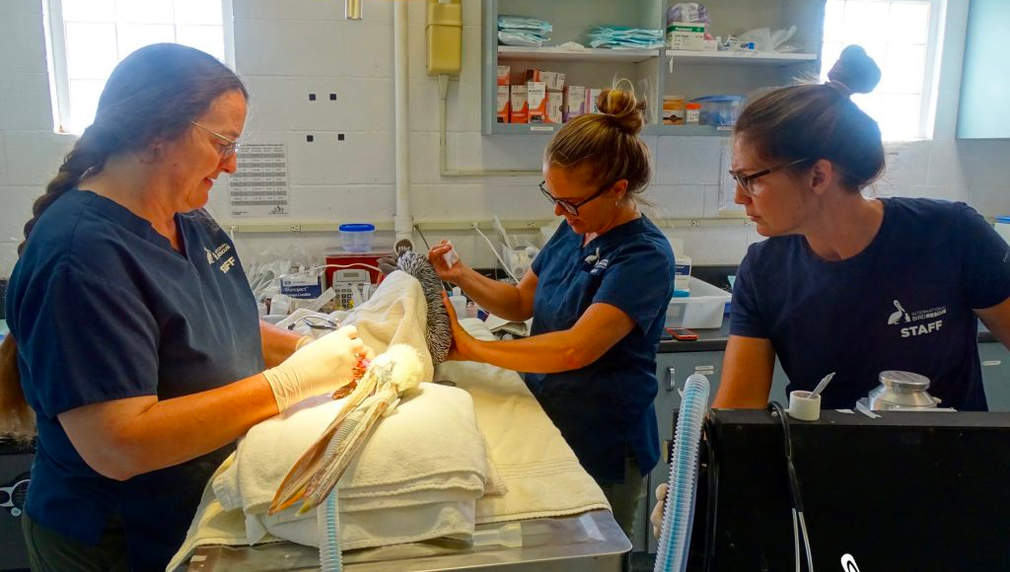Local Native Wildlife Rescue and Rehabilitation
Our Wildlife Rescue and Rehabilitation program provides an immediate, practical, ethical, effective, and humane solution that mitigates human- and industrial impact on the environment and mitigates animal suffering for local, native wildlife, 365 days each year.

What is the primary issue area that your application will impact?
Climate and Environment
In which areas of Los Angeles will you be directly working?
County of Los Angeles
In what stage of innovation is this project, program, or initiative?
Expand existing project, program, or initiative
What is your understanding of the issue that you are seeking to address?
Birds are sensitive indicators of changes in our environment, and their health is failing. Experts around the world agree that aquatic birds are in crisis: - “Since the 1970’s, [North America] has lost 3 billion birds” (Science, 2019) - “Shorebirds, the World’s Greatest Travelers, Face Extinction” (New York Times, 2018.) The causes of this population collapse are almost all caused by humans. They include injury from fishing (hooks, nets, and lines), illegal shootings, habitat disruption and loss, starvation, pollution (including plastics, chemicals, and oil spills), and climate change. LA is especially important to hundreds of species of aquatic birds (many that are endangered or threatened) because of its central location on the Pacific Flyway: a major North-South migratory route along the coasts of North and South America. Immediate human impact here has concentrated, long-term effects on the global wildlife population.
Describe the project, program, or initiative this grant will support to address the issue.
At Los Angeles Wildlife Center, we rescue and rehabilitate an average of 1,500 native aquatic birds each year, and release them back into the wild. Since our inception, we have rescued and rehabilitated over 160,000 wild animals, representing over 115 different species. As a "referral hospital," we treat the most challenging injury cases that are beyond the capacity or skills of other regional wildlife centers and clinics. While many of our environmental partners focus on systemic issues such as habitat loss/conservation, we provide equally important, immediate, and present day responses that mitigate human impact and quite literally save and improve the lives of individual animals. Each case we treat is a step away from the negative effects of human impact and activity, and towards restoring biologicl diversity and balance to our local, regional, and global ecosystem. A core objective of this program is to give each injured bird the individualized care it needs to heal. This philosophy and value, that "Each Bird Is Important," has been a guiding principle of our work for decades and is beautifully explained by former Executive Director, the late Jay Holcomb, in the 2011 Emmy Award-winning documentary film "Saving Pelican 895," "Populations are made up of individuals, and if you start looking at individuals as if they're not important, then ultimately the population becomes unimportant."
Describe how Los Angeles County will be different if your work is successful.
Local LA residents will have an immediate, practical, ethical, effective, and humane solution that mitigates human- and industrial impact on the environment, and mitigates animal suffering for local, native wildlife, on an ongoing, as-needed basis. Because we can provide this free-to-the-public service on an ongoing basis, we keep are skills and our facility ready to respond to unpredictable, yet sadly-inevitable environmental crises that occur, such as the three well-publicized catastrophes we responded to in the last year: the Long Beach Harbor Seabird Rescue (which saved over 3,000 near-threatened Elegant Terns after a human-piloted drone crashed i their nesting grounds), the Amplify Pipeline Rupture near Huntington Beach, and the current 2022 Pelican Crisis. LA will be different because regular citizens can become environmental champions when they rescue birds in distress, and whole generations of wildlife can be saved and contribute to biodiversity.
What evidence do you have that this project, program, or initiative is or will be successful, and how will you define and measure success?
Throughout a patient's time with us, from their initial triage assessment to their release, we record data using RaptorMed software. Treated birds are banded and can be tracked in the wild by other scientists, volunteers, and enthusiasts, and in case a treated bird returns to us for further care. We are one of the few organizations that possess the federal permit to band birds. Birds successfully rehabilitated are given “second chances” and return to a normal life. They participate in normal species behavior, such as producing and rearing offspring. Each of these outcomes is an important component of a balanced, diverse ecosystem. Our scientific data provides strong evidence that birds injured by human impact that we successfully rehabilitate (whether the impact is from oil, pollution, or other forms of human-caused Human Wildlife Conflicts such as habitat loss, food scarcity, abandonment, climate change, or fishing entanglements) lead lives that are long and productive.
Approximately how many people will be impacted by this project, program, or initiative?
Direct Impact: 4,500
Indirect Impact: 100,000